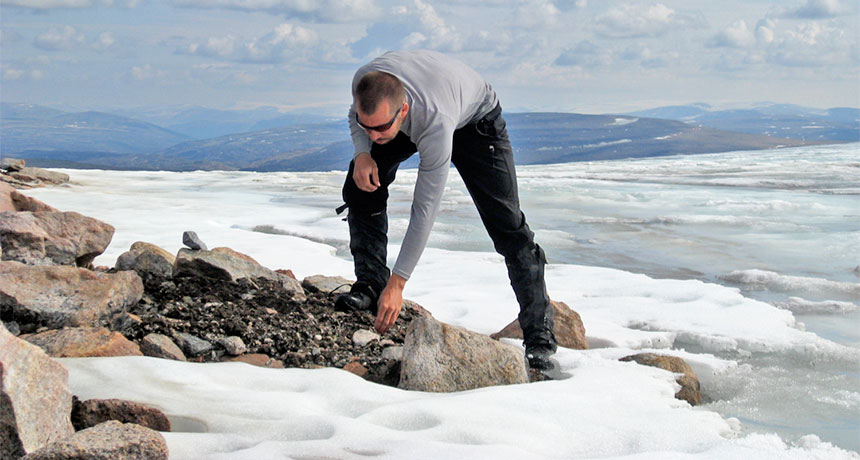Thawing mosses tell a climate change tale
Dating of plants suggests summer is hotter now than it’s been in at least 45,000 years

Geologist Kurt Refsnider, now at Prescott College in Arizona, collects mosses that were revealed by retreating ice on Canada’s Baffin Island. Radiocarbon dates for the mosses suggest the region has less ice cover now than it did tens of thousands of years ago.
G. Miller
SEATTLE, Wash. — Some mosses in Canada’s eastern Arctic have long been entombed in ice. But now, rising temperatures have been melting that ice, bringing those mosses to light. By dating how long ago those mosses were buried, scientists now conclude that summertime temperatures in this region are the warmest they’ve been in tens of thousands of years.
“We were stunned,” said Gifford Miller of the University of Colorado Boulder. As a paleoclimatologist, he studies ancient climate. At some sites he studied, the emerging plants last saw the sun no less than 45,000 years ago. Some may have been buried for up to 115,000 years.
Miller described his findings October 22, here, at the Geological Society of America’s annual meeting.
As the planet warms, ice has been retreating on Baffin Island, in Canada’s far North. Miller’s team has been probing the plants unburied by this melting.
They collected an impressive number of samples, and their findings are very compelling, said Lee Corbett. She’s a geologist at the University of Vermont in Burlington who was not involved in the study. “It truly is an indication that humans are pushing the climate into a new regime,” she said. She points out it’s “one that modern, agriculture-based civilizations have never witnessed.”
Dating mosses
Miller’s group wanted to track the growth and retreat of Baffin Island’s ice cover. To do this, they have been hunting for remnants of scraggly mosses along the edges of the island’s retreating ice sheets.
The newly exposed mosses are dead. (At least for a year or two. Then they come alive again. That’s why Miller calls them “zombie” mosses.) The researchers could tell when the mosses were last exposed to the atmosphere and using sunlight to perform photosynthesis by looking at their carbon. They used a technique called radiocarbon dating.
Some elements, such as carbon, come in forms that have the same number of protons but different masses. Each of these is a different isotope. Carbon has three isotopes. Only one of them — carbon-14 — is radioactive. It has a half-life of about 5,730 years. After that period, about half of the carbon-14 atoms in the original sample will have decayed into a new isotope. Radiocarbon dating compares the ratio of carbon-14 to carbon-12 in some sample. This ratio changes as carbon-14 decays. And the ratio corresponds to when the moss was last alive.
After about 45,000 to 50,000 years, though, almost all of an objects’ radiocarbon will have decayed. The radiocarbon dating technique won’t work for anything older than that.
So far, Miller’s team has determined the ages for 370 different plant samples collected on Baffin Island. Those ages tend to cluster into groups. Each represents a time when the ice expanded across the island to entomb the affected plants. One large group dates to around 3,700 years ago. Another is from around 900 years ago. A third dates to around A.D. 1450, corresponding to a cold period known as the Little Ice Age.
But in a few regions, the plants were so old that they had no carbon-14 in them. Mosses with the “dead” radiocarbon were found at high elevations. They were on pedestals of rock with persistent ice caps that are now slowly melting. Because the radiocarbon clock stops at about 50,000 years, it’s not possible to see exactly when those spots were last ice-free. But an ice core collected in nearby Greenland suggests that the planet experienced continuous cold from 40,000 to about 115,000 years ago. That’s when the planet’s previous warm interglacial period ended, Miller noted.
Originally, the researchers expected to find plants dating to medieval times. That would have suggested that the region is the warmest it’s been since the Middle Ages, which ended in the 14th or 15th centuries. But finding 3,700-year-old plants was a surprise, Miller said. And “we never anticipated we’d find plants 40,000 years old,” he added.
Indeed, he says, “It’s a bit spooky because it provides quantitative evidence that the magnitude of summer warmth is already sufficient to melt all ice in the eastern Canadian Arctic. It’s just a matter of time now.”







